| ← Август 2025 | ||||||
|
1
|
2
|
3
|
||||
|---|---|---|---|---|---|---|
|
4
|
5
|
10
|
||||
|
12
|
13
|
14
|
15
|
16
|
17
|
|
|
20
|
22
|
23
|
24
|
|||
|
25
|
26
|
28
|
29
|
30
|
31
|
|
За последние 60 дней 22 выпусков (2-3 раза в неделю)
Сайт рассылки:
http://best.moy-forum.net/
Открыта:
10-08-2009
Статистика
0 за неделю
Production 1: Materials
|
Production 1: Materials 2025-08-11 10:20 alienshooter I wanted to write a detailed guide to production in the game, based on the fact that any construction has three stages: 1) Extracting materials 2) Manufacturing the product 3) Selling finished products Each of the stages can be optimized, and thereby earn more ISK, or lower the price and sell the goods faster. Construction t1 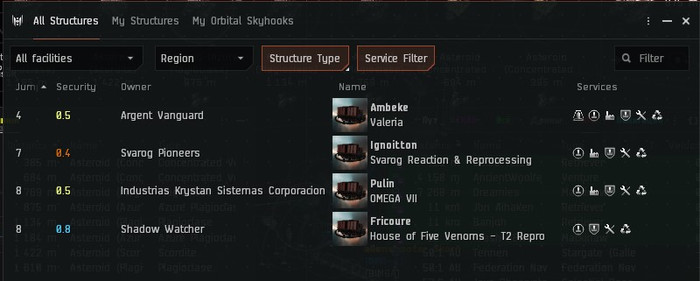 Method 1 Let's say for the construction of t1 modules, we need 10,000 tritanium. In 100 veldspar there are about 400 tritanium, with 100% processing skill. This means that with a processing skill of 50% we will need about 5,000 veldspar. The situation is better on omega, and by pumping up skills, you can achieve an exhaust of about 70%. And if you find a Tatara with a T2 rig for processing in the structure browser, you will get the maximum value in highsec, which is about 75% during processing. The same Tatara, if it is in lowsec, will give 85%. The same Tatara, only in nullsec or WH, if it is worth it, will please the max with an exhaust of 95% . Accordingly, you can calculate:
In other words, if you buy compressed ore in the high sector, and take it to nulls or WH with omega to Tatara with a T2 rig and max trained skills, you will need half as much ore to build the same Vexor than to do it on Alpha in highsec. As far as I remember, people said that the ceiling when it is profitable to process ore is if you have 70-75% processing, then you have basically broken even, i.e. it makes no difference to you whether you buy minerals or ore and process it. Everything above that is income, everything below is better to sell compressed ore and buy minerals. On 09/13/24, suddenly the admins will change something. Method 2 Minerals can be obtained from junk modules from rats and agent missions. So you can get, in addition to highsec minerals tritanium, pierite and mexallon, lowsec: isogen and noxium, as well as nullsec minerals: zydrine and megacyte. On alpha, you will have 50% of the exhaust from processing junk. And on omega, about 55%, I think. Method 3 You farm ISK in some way, and buy minerals directly with them, highsec minis as close as possible to the future construction site, there are a lot of them, and lowsec and nullsec minerals can be taken from any trade hub and taken to the destination. Rig production The principle is the same, only you no longer do mining, but scan relics in nullsec or wh, or salvage, wrecks from combat. You can also buy a banal salvage in the hub and bring it, it weighs little. 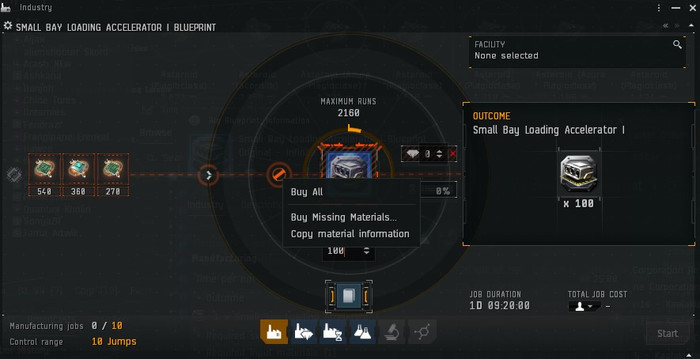 of the downsides of rig production is that you need omega to improve the blueprints. One of the pluses is that the profit is not bad. T2 production Congratulations, this is where the happiness and grief of the builder begins. The happiness is that there is more profit than T1 construction, and the grief is that there is more hemorrhoids in obtaining materials. 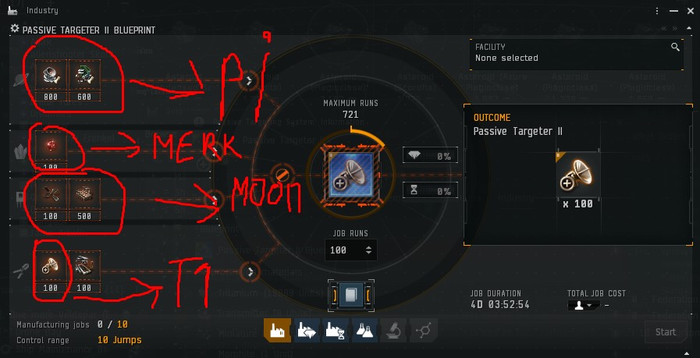
Let's start from afar, there are moons and moon ore in the game. Moons are R4, R8, R16, R32, R64 in terms of resource value from simple to complex. In addition to ordinary minerals, the moon also gives materials for reactions. The latter can be made according to the formula on athanors and tatars in lowsec and below, where there is a corresponding reaction module. Accordingly, to craft 100 components of the Ladar sensor cluster: 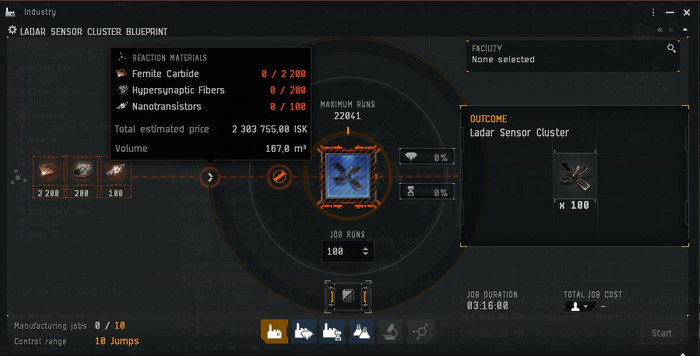 You need a certain set of materials obtained from reactions. If you are already falling into depression, then it is better to just buy a ready-made component on the market in the required quantity, a Ladar sensor cluster and build T2 modules from it. So as not to travel through lowsec to Athanor. Reactions are such a voluminous hat that there are people who only deal with them, and do not get into T2 components, and even more so into construction, so that you understand. But the benefit is that you can already at this stage earn money on manufacturing, getting cheap reactive materials, and not buying with a markup in Jita. If you are not scared by the complexity, let's move on: 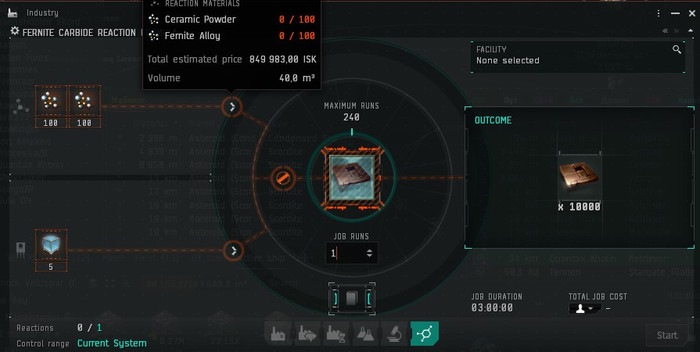 Complex reactions on Athanor consist of simple reactions and fuel blocks. How to craft fuel blocks - mainly you need ice, materials from its processing and a planetary:  And how to do simple reactions: 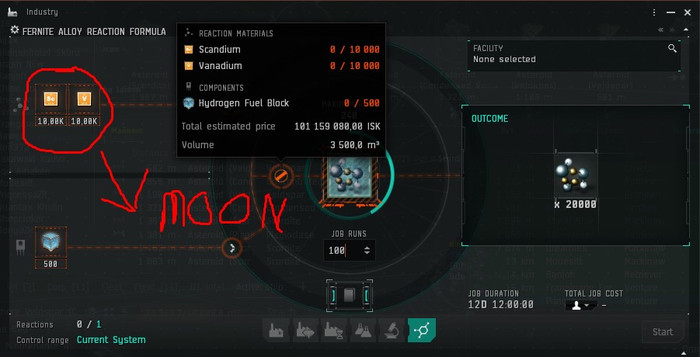 You need fuel again and materials that are obtained by dmining moon ore. Well, again, everything can be bought in the market, sacrificing profit. How deeply you will immerse yourself in the construction depends on you. We are only going to discuss obtaining materials for construction, the first of three parts, and everything is already complicated. It is not for nothing that this manual on production is being written on Friday the 13th, because, hell yeah! And in such a "simple way" we get materials for building t2 modules. Of course, you can sacrifice profit, buy everything on the market and not bother. How to get 1kk sp on main / Как получить на основу 1кк сп? On any account, even an old one, follow the link, and at the bottom under the fields, click "Log in to become a recruit". You don't need to fill out the form: 1млн навыков бесплатно сп / 1mln free skills. Building citadels and structures 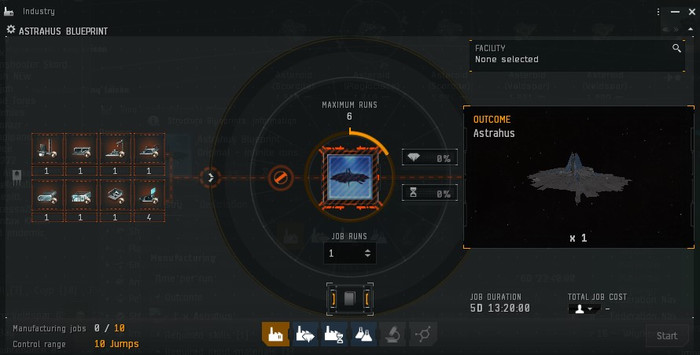 It seems like nothing complicated, you just need some parts of the structures and a copy of the drawing. What are the parts for building citadels made of? 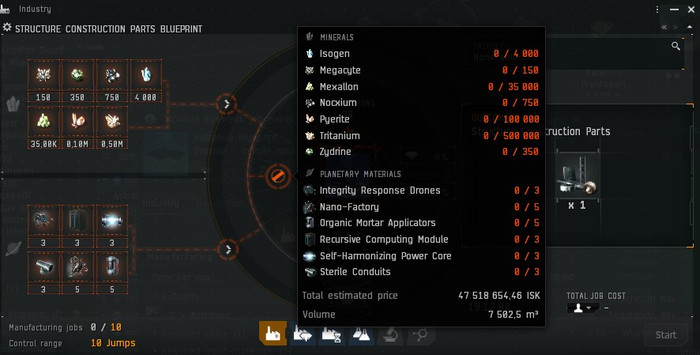 We see minerals again and a planetary of the highest type, this is t4. That is, again we will have to somehow extract minerals and rigidly planetarize, or make t4 from t2, etc. Or from t0 - t4. But parts for the astrahus are crafted on alpha. On 09/13/24. And there are no reactions \0/ Capital construction Let's say we wanted to build Rorqual, first of all, this cannot be done in the high sector, only in lowsec and below on NPCs stations or player structures with capital module: 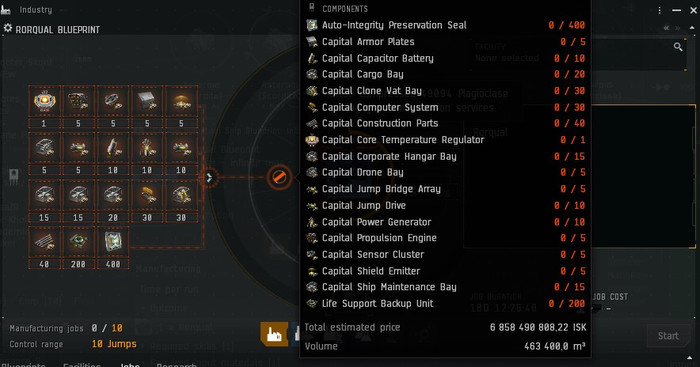 It looks scary, doesn't it? It feels like we're getting into some kind of hat again... Let's take a look: The simplest thing on the list is a t2 planetary and reactions. 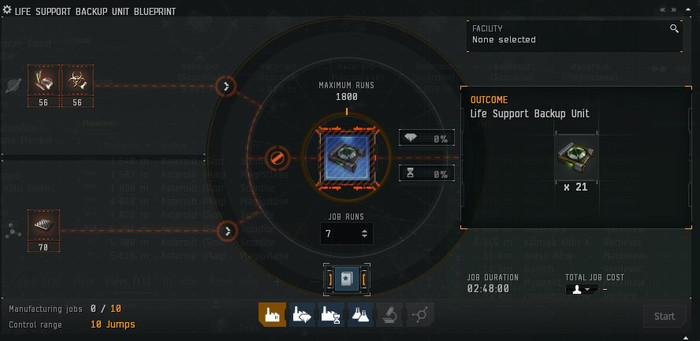 Next, to build a capital component, what do we need in terms of resources: 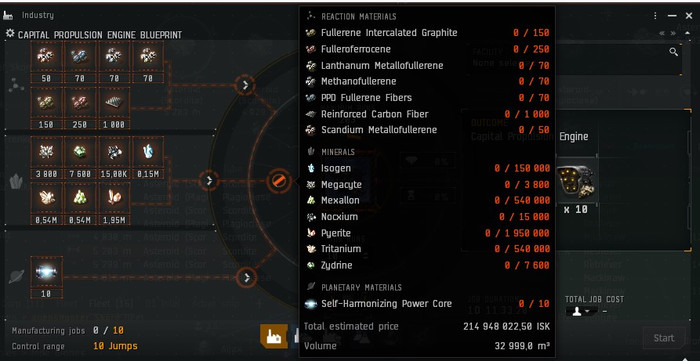 Again, standard minerals are common, then a t4 planetary and reactions, and not only the reactions we've seen, but also new ones that require gas: 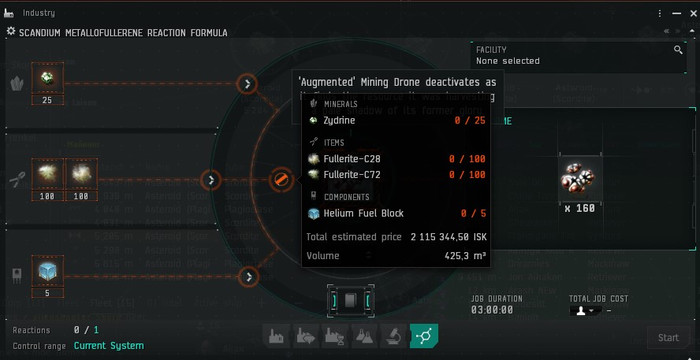 Gas can be obtained by mining it in wormholes (WH) on anomalies, lowsec, nullsec, or by buying it on the market again. There seem to be three types of reactions in total, from which boosters are made, then implants, and modules with ships, if I'm not mistaken. But I seem to be mistaken with the implants, correct me in the comments. Boosters Since we've already let's talk, let's see what they are made of? What materials? 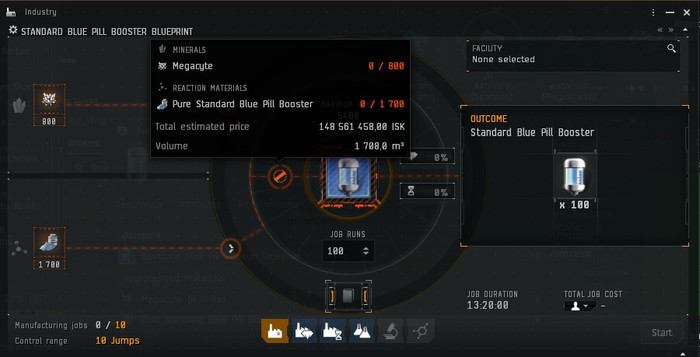 These are minerals and reaction derivatives, which in turn are made of: Planetary, lowsec-nullsec gas and fuel blocks, which are made of ice and PI. 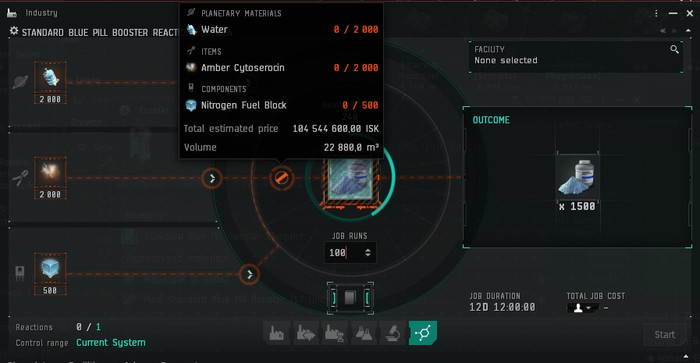 Implants There seems to be nothing complicated here, we see a T3 planetary and morphite: 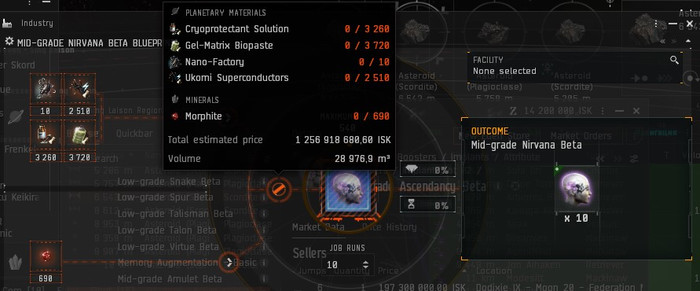 It is also crafted on alpha T3 construction As in the case of capitals, you can only build in lowsec and below. You can't in highsec. Very tied to highsec gas. 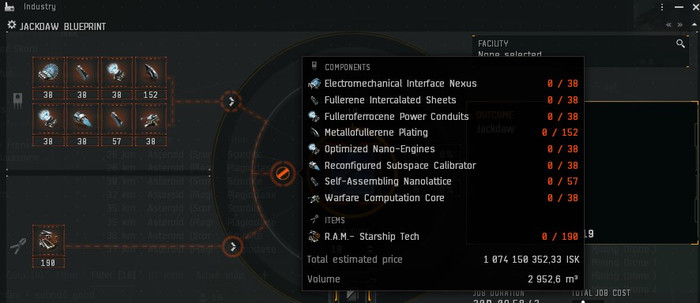 I remembered. It turns out there are three types of reactions, for boosters, for t2 and for t3 construction. 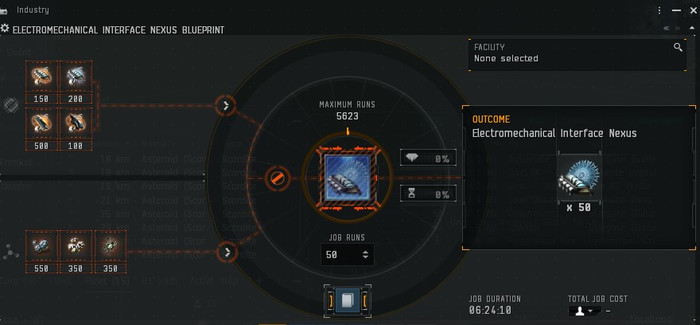 Components for t3 construction are assembled from a special, cheap salvage, most likely from wh, and reactions with gas: 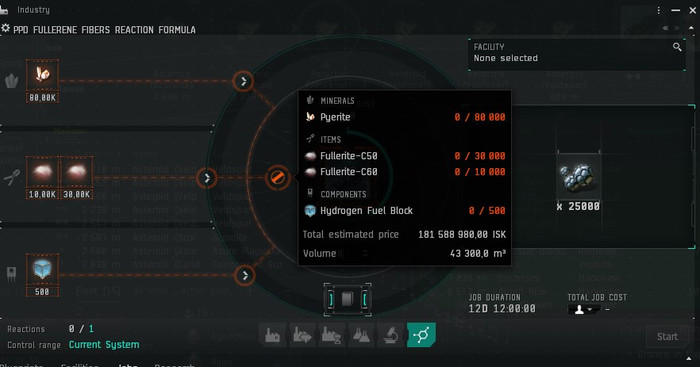 These seem to be the main types of construction in the game, and ways to obtain materials for them. Of course, you can forget about profit at any stage and just buy up the necessary resources in the trade hub if you simply do not have enough time and nerves to carry and build all this. By the way, you can generally forget about construction if, after reading the first of the three parts, you have a clearly expressed rejection. And those who read it and did not change their mind about building, put + in the comments. After all, in the second part, called "manufacturing", we will talk about where you can produce assets and whether the location / improvement of blueprints affects the profit o7 Production 2: Manufacturing 2025-08-11 11:08 alienshooter In the previous part of the production guide, we talked about how to get materials for work, and what types they are, how ore processing differs depending on space, what a planetary and reactions are for, what moon mats are, etc. The only thing we didn't mention is that there is also the construction of faction ships, parts for which are bought in the LP shop of pirate factions, on 09/14/24 Today we will talk directly about manufacturing, i.e. you already have something to build something from, and at the first stage of processing / obtaining resources you have already earned. Or let's say you did the simplest thing - bought up materials for construction in the Jita, thereby killing part of the profit. If so, then it doesn't matter, because you can also make a profit at the production stage. Manufacturing of T1 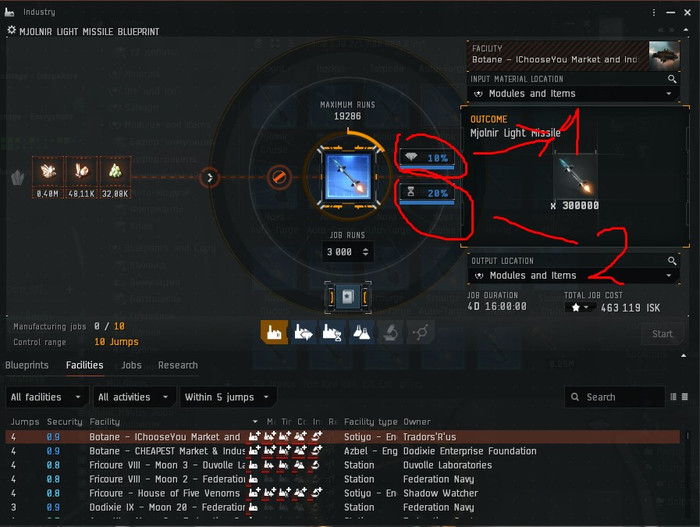 Obviously, you will have to improve all blueprints to 10% material efficiency. But the 20% production acceleration is also important, because for example on 100s with rigs for ammo speed, your resource costs will be reduced due to this. Then you will have to look for stations with rigs for production, reducing material efficiency, increasing production speed. As with ore processing, the best construction indicators can be achieved in nullsec or wormholes with T2 rigs, which will additionally reduce your material costs by up to 5%. In lowsec, the same 100s with nullsec and wormholes will give 3-4%. In highsec, an additional 1-2% reduction in costs. You already know the second indicator, this is the system production index, it is obvious that in Jita it is better not to build anything because of the commission, but to look for empty systems nearby, with a small number of builders. Your own station Then, you can come to the conclusion that it would be nice to put a raitaru in highsec or wormhole, lowsec. So that everything can be done profitably on it. The idea is good, the only problem is that stations can be attacked by other players and they often do this, because of the loot (a core for 700kk drops from a raitaru, for example) or for strategic reasons (Pandemic Horde from pirate corps periodically burns out all stations in Gallent and Matar to remove competition from their iChoouseUMarket sotio, they don’t go to Amarr because there are Goons there, and they don’t burn out their space in Caldari because of Fraternity). Accordingly, the installation of the station should be paired with the fleet that protects it. This is how it works in the game at the moment. Your station = fleet for protection. The second option is to hide the citadel, not to make public docks, in some non-passable system. With a timer inconvenient for local pirates. So that until you are found, you can produce goods with a cycle of no more than 7 days, and recoup the costs of the station). How do you know if you can defend a station, i.e. if you have a sufficient fleet? If you can destroy other stations with this fleet, then you can defend too. And if 3 people arrive to defend, and one of them is you, then it's worth thinking about. Rig construction
T2 construction Here, at many stages, you can make a profit: 1) Brew reactions yourself 2) Make components for t2 construction from reactions and improve blueprints by 10/20 for component production. 3) Do a planetary industry by yourself and do not sell it, but use it in construction. 4) Build t1 modules for the production of their t2 versions yourself, too, using improved blueprints. 5) You can ignore the potential profit and buy everything in the trade hub. Invention There is a peculiarity with t2 construction that you don’t need to improve the t1 blueprint for this, you can just buy 0/0, make a copy of it, and improve the copies in t2, and at the output you will get a full-fledged recipe for construction. Or find the needed t1 blueprint in the contacts that has already been copied, it’s even cheaper. 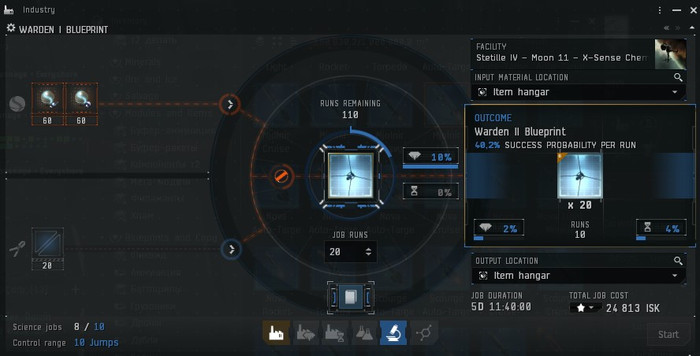 Then, after the inventory, at the output you get a bunch of t2 blueprints that you can build, usually for 10 runs, unless these are ships: 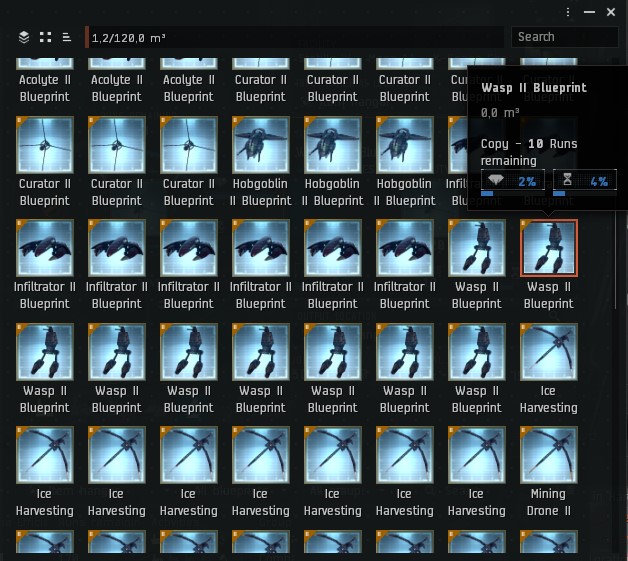 But the main problem is not to invent the blueprints, but to find the materials for construction and the place. Now regarding the disks. They are often used for the number of runs if they are making t2 frigates, and for material efficiency if they are building marauders. How to get 1kk sp on main / Как получить на основу 1кк сп? On any account, even an old one, follow the link, and at the bottom under the fields, click "Log in to become a recruit". You don't need to fill out the form: 1млн навыков бесплатно сп / 1mln free skills. Where can I do inventing? At NPC stations, the weakest invent. A structure with rigs can speed up the process by up to 50%, i.e. you will get the necessary t2 recipes twice as fast. PM By the way, this way you can make recipes for t2 rigs, for example. Capital construction The same as t2, like in many processes you can reduce the cost of your product. It is trivial to improve the BPs for components for capital ships, for example in 10/20, then weld, the planetary yourself, reactions yourself, find stations in nulls or lows or in wh with rigs for capital construction, etc. Lyrical digression Let's say you want to build t1 lenses for large lasers, open the blueprint and see: 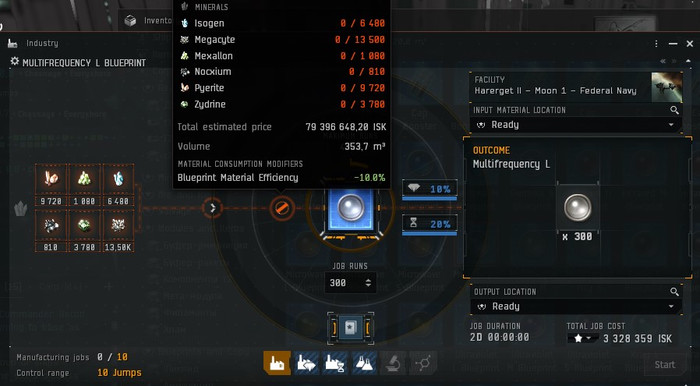 It costs 83kk to build 300 lenses - that's the cost price. You also need to sell them at a 10-20% markup and add a 5-10% commission on the sale. Then we open the market and see this: 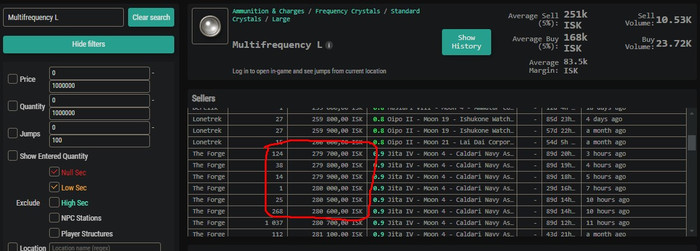 The cost price is 84kk, and we're lucky, because the cost price is often lower in the git than we have for construction. Question: Do you need to build them, lenses? The answer is no. It's easier to buy in the git in this case. This happens because all T1 consumables drop from NPCs, and they can often be cheaper on the market than your cost price during construction with a 10/20 blueprint. Construction of citadels and structures Here, too, you will have to improve the blueprints for building components for structures in 10/20. Well, and find a good copy of the blueprint of the citadel itself in contracts, so as not to buy the original for many billions and not improve it for several years. Boosters and implants As far as I understand, they are maded from copies, and profit can only be obtained due to the station where you produce reactions for boosters, or citadels where you build implants. T3 construction The same thing, improve the drawings 10/20 for components for t3, and look for stations with rigs for t3 construction in lowsec, nullsec or vh. Conclusion As you can see, at the manufacturing stage, you can get a benefit by improving the BPOs by 10/20, a significant profit depends on the station where you build, its rig and the space where the structure is located - lowsec, wormhole, nullsec. By the way, I forgot to mention that there is also a triglav construction, materials and BPCs are obtained by passing the abysses. Those who read to the end and did not change their mind about building, put + in the comments. After all, in the third part we will talk about the selling of finished products. Production 3: Sales 2025-08-11 12:02 alienshooter Congratulations, you have reached the final part of the guide to building in Eve. As you already understood, at each of the three stages of construction: processing and collecting resources, production, and sale of goods, you can make money. Let's simulate a situation when we screwed up the stage of earning on resources by simply buying them in Jita, then we could not find a station with rigs in low, high and null, we have no friends there and we always drink with our own money. But there is still a desire to make money on the built product. How can this be done during the sale? 1) Omega and tax If you are an omega, then you are lucky, because you can reduce the tax on the sale of an order from 10% on alpha to 4-5% due to skills. That is, you can either earn more, or deliver the product cheaper so that it is bought faster - higher turnover. 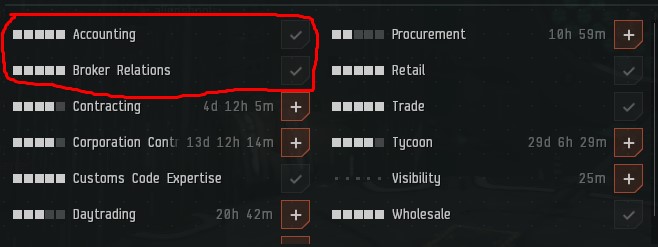 These are the two skills that interest us, it is advisable to training them up to the maximum. 2) Corporate projects If you are an alpha and want to sell some goods or resources without a commission, then sometimes it is a good idea to look into corporate projects and see if your corp is currently buying up what you want to sell. The beauty is that there is no 10% commission. And if you are satisfied with the price, of course. 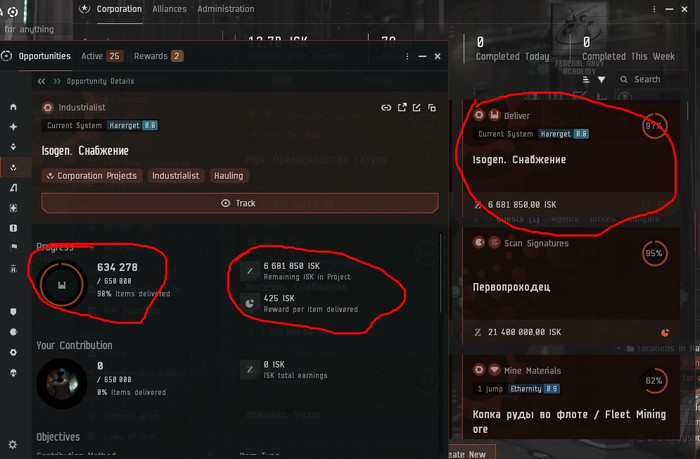 3) Contracts You can sell goods through contracts, also bypassing the 10% commission. Capital ships and subcapitals with ready-made fits are often sold this way. 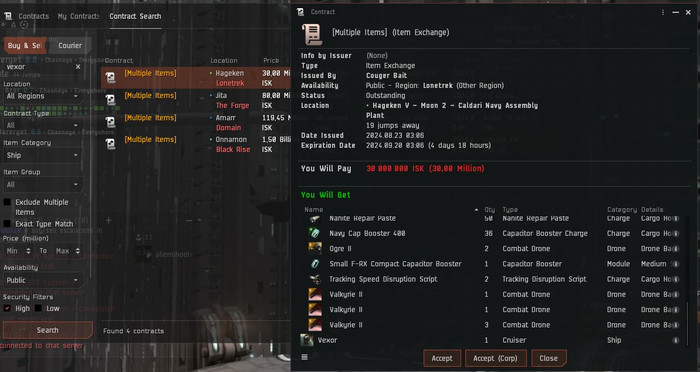 4) Order If you did not build for sale, but to order, for example, 100 Cyclones, then you do not have a stage of product implementation, and you do not need to bother with making a profit. The same thing happens if you sell built items on a buy order, having previously calculated whether it is profitable. 5) The path of the peripheral builder This is where things get a little tough and fun. In short, let's say we built 10 Vexors at the lowest profit, which is to buy minerals in Jita and produce everything at the NPC station, but using an improved 10/20 blueprint: 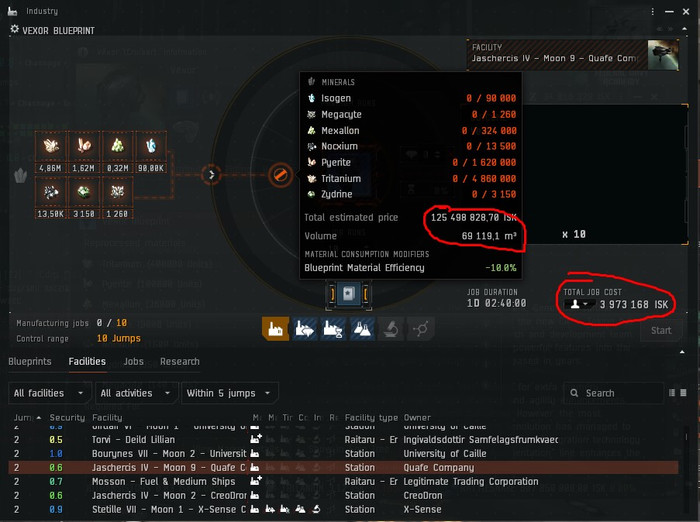 Our cost price of 10 Vexors is about 130kk ISK. Where can we go with such indicators, except to hell? Let's take a look: Jita 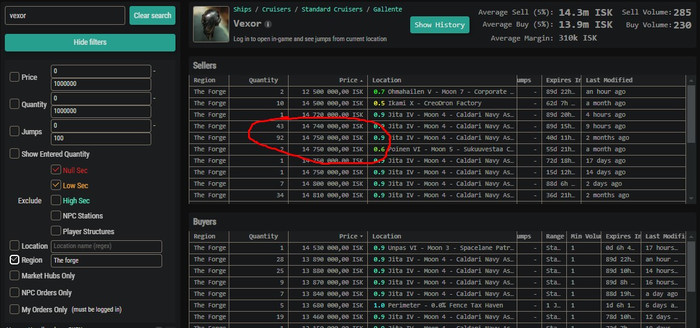 In principle, not bad. If you place a sell order and wait until someone sells 130 Vexors, given that there will be no new orders, you can make money. Unfortunately, it won't work to dump the ships using buy orders, since you will need Omegas to get 100k profit from the ship, and this is not enough, then it is better not to do this at all. Dodixie Welcome to the real world, where goods on the market are cheaper than your cost price according to the 10/20 blueprint. Why is it that Vexors are 12kk if your cost price is 13kk? Two options: 1) A trader bought a vexor by buy order for 9kk and delivered it for 12kk. 2) A producer bought compressed ore in Jita, took it to Nulls, Wormhole or Low, to Tatara with a T2 rig, processed the ore with an exhaust of 80-90%. Received minerals 30-40% cheaper, and built a vexor on a hundredth or Raitaru in Low, WH, Nulls, with a rig by 5% to reduce material costs, which further reduced the cost price. Vexors with a cost of 8-10kk (or maybe lower?), he brought to the highsetor to the trade hub, and put them up for sale at 12kk. And again bought compressed ore for the next construction. So as not to travel back and forth empty-handed. Periphery (all regions except those in which the main trade hubs are located. We exclude Forge, Sink Lyson, Metropolis, Heimatar, Domain). As an example, the Essence region is taken: 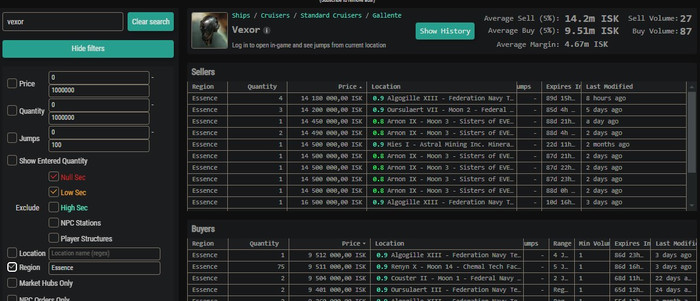 Look, we see light at the end of the tunnel! This is where you can unload the Vexors we built and still earn ISK. The only problem is that the trade turnover in the periphery is many times less than in the main trade hubs. Therefore, you will have to be clever and look for systems for faster sale of items: 1) Traffic 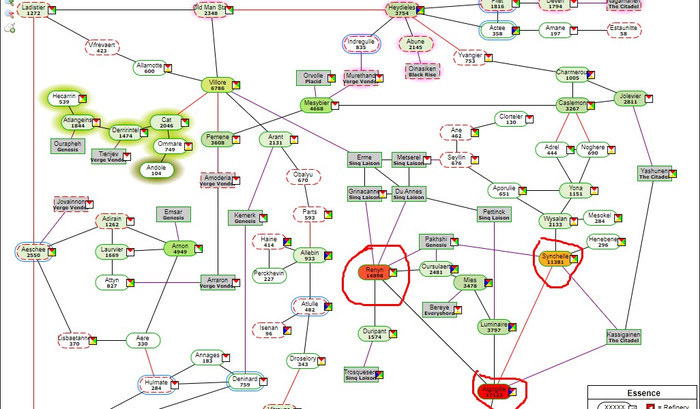 Obviously, a wallmarket in an underground passage or at a train station will bring in more money than one that stands on the outskirts or in an open field. The same principle applies to systems, according to Dotlan, those with the highest traffic per day are selected. 2) Fraction War 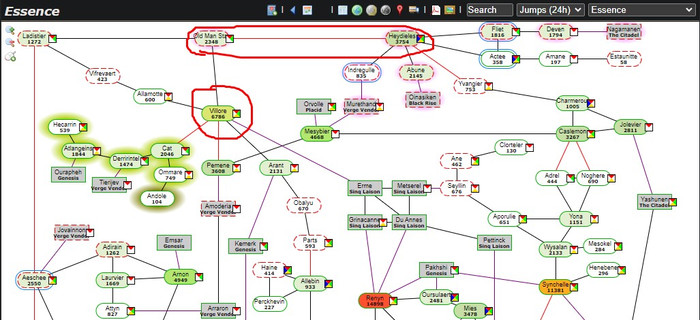 The second way to quickly sell Vexors on the outskirts is to choose a system near lowsec, where factional wars are taking place, where everyone happily fights every day. In Essence specifically, this is the Villore system, for example. There are regions where there are no factional wars at all. 3) Convenience 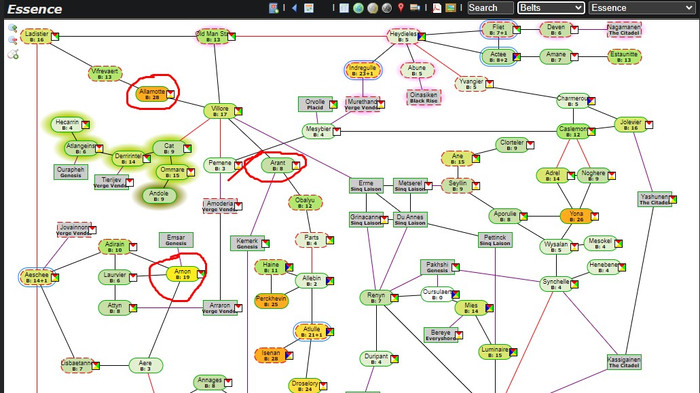 If for you, as for Elf, 100 years is just a moment, and you are ready to freeze ISK in the form of Vexors on the market for several months, then it is better to choose a system based on how many belts it has for digging, and whether there is a factory to build everything on site. Also a way to sell goods at the right price, freezing them for an indefinite period. 4) Assortment 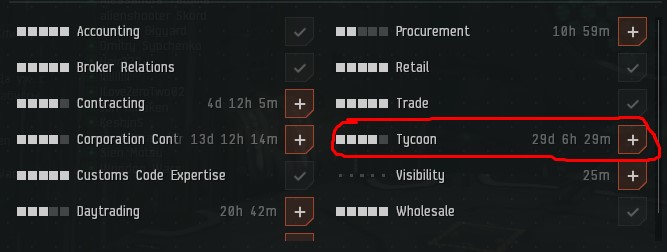 You can make Vexors sell faster on the outskirts by increasing the range of goods at the same station, like a supermarket. Like the prices are higher compared to the hub, but the range is very good, and you can assemble everything on the spot, in one minute, instead of flying 15 jumps to the Jita back and forth. Some people even assemble a ship by flying to all the trade hubs, looking for the cheapest module for a couple of thousand, while spending almost half a day in the game. Then they fly to low, their ship is killed and they do not return to the game. /0\ In this case, we will have to max out orders if you are an omega, or create new accounts and place orders from them, on alpha. Popular belief says that: "If a lonely builder has appeared in a region, then this is a great grief for traders, and happiness for ordinary pilots!" Indeed, for just a couple of hundred sell orders and a couple of months of time, local Essence traders will hate you, because with your low cost, and accordingly, the price of the goods, you will break their profit. And ordinary players will be grateful to you because they will be able to buy more items for the same amount of ISK and in one place. How to get 1kk sp on main / Как получить на основу 1кк сп? On any account, even an old one, follow the link, and at the bottom under the fields, click "Log in to become a recruit". You don't need to fill out the form: 1млн навыков бесплатно сп / 1mln free skills. 5) Sansha Invasion and Storm (winter event) 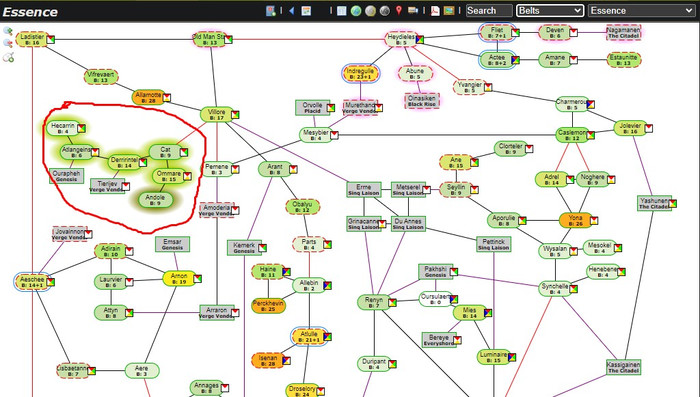 Now in Essence there is an Invasion randomly happening, and this is a good reason to mention an interesting fact: when a Sansha invasion occurs in the system on the periphery, or a storm during the winter event, then trade is greatly boosted, turnover, the number of trade operations, etc. increase several times. A good reason to sell items. The only the question is, how to make it so that in the system where you trade Vexors, there is such an event every day, and not once every six months? Here you can come up with your own. How to calculate the markup 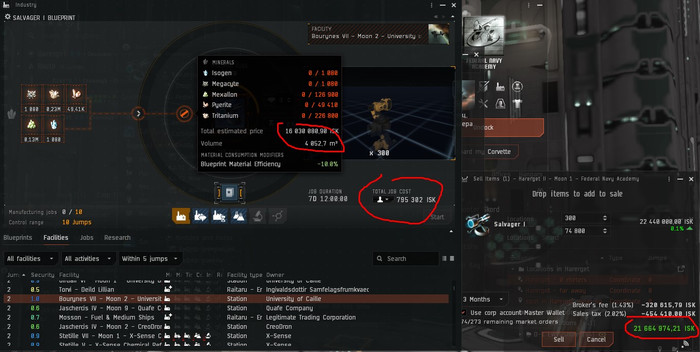 About 17kk of salvagers, 21.6kk of sell sales. Net - 4.6kk. In percentages, 1.7kk is - 10%, 4.6 / 1.7 = a markup of about 30%, this is our earnings). Conclusion. Is production in Eve a scumbag? After reading the three parts, you might have a logical question: why buy and study blueprints, then learn ore processing so that the refinement percentage is higher, look for stations where you can process profitably and build, learn reactions, a bunch of inventory skills, understand the planetary production, what tiers are in it, look for the lowest percentage at customs. Also learn skills for trading, to just get profit from manufacturing? Why do all this, if you can just learn skills for selling goods in max, put in the live buy orders, wait, deliver the goods to the required region, or order a courier and just put them up with a 50% markup for sale there, and earn normally, without all this? Yes, that's true, with one small clarification that production in our game can give something that trading will never give. For example, you need to put 100 depots up for sale in Dodixie because speculators bought out all the depots at 2kk and moved them to be sold at 3, or players quickly took apart sell orders: 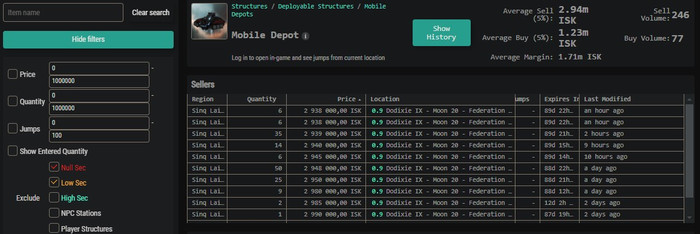 As a good, self-respecting trader, we look at the Jita: 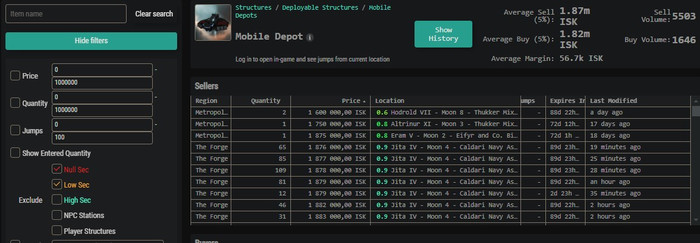 And we see depots at 1.9kk. That is, you can spend half an hour, bring the depot to Dodixi, put it up there at 2.36kk and earn ISK. And if we are a smart trader, then we will buy in the Jita with a buy order, for example at 1.7 or 1.8kk. Let's see how the builder sees this situation: 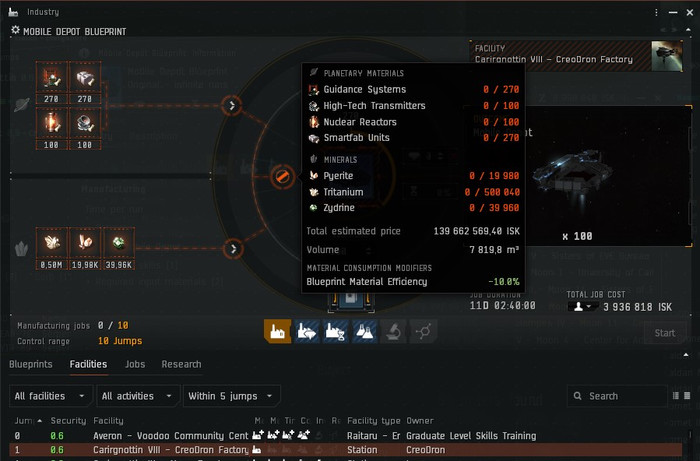 We see a mobile depot at 1.44kk, this is with resources bought in Jita, and items built on the NPC station. If you get a profit from all three stages, i.e. weld a planetary yourself at customs with 0%, process ore into minis with an exhaust of 80-90%, build a blueprint on a hundred or a raitaru in Low, Wormhole or Null with the necessary rigs, then it seems to me that the cost will be about 1.1-1.3kk. In other words, production in EVE is good because you will always have a lower cost than traders, excluding T1 meta modules, initial frigates, etc. And at least because of this, there is some profit or benefit to doing this. In addition to the fact that you just like to build. Whoever read all three parts to the end and did not change their mind about producing in the game, put a + in the comments. Production 4: Evolution 2025-08-11 12:40 alienshooter The motivation for writing the fourth part of the construction manual was several factors:
Eden Trade question at Fanfest In 2019, Eden Trade was farming agent 4 on a marauder, and he ran out of missiles, he did this on the outskirts. And when he opened the market to buy ammo, Eden saw that no one was selling them. Then he asked himself: "Why, for 20 years of Eve's existence, is Jita not in every region?" Like, for such a period of time, the game should have had, roughly speaking, the TV series "Babylon 5". Because of this, Eden started trading in 10-20 regions across the galaxy. And the sad news is that even after a few years, he is the only one who sells missiles for his Marauder. But for 20 years of the game's existence, the powerblocks were able to build Keepstar near Jita with a multi-billion dollar monthly income and divide the ISK from it equally among everyone. Of course, in the end they did not divide the ISK and later demolished it themselves. Next, in each region of the Pandemic Horde, they installed hundreds of iChooseYou Market. Roughly speaking, a monopoly. Then, in the 21st year, Fraternity produced 50% of all items in the game, their sales market is Jita. And the Goons market for sales is, accordingly, Amarr. Well, we do not remember the sawing of structures of solo players in highsec by pirates, or power blocks from alts, or pirates, at the request or funding from power blocks. Because it is a monopoly and competitors must be fought. Volume is not that important If we use the rating of all markets that currently exist in the game, we will notice an interesting feature: The main trading hubs - Jita, Amarr, Dodixie, Rens, Hek have at least 1 trillion volume of goods in sell and buy orders: https://dev.adam4eve.eu/market_hubs.php 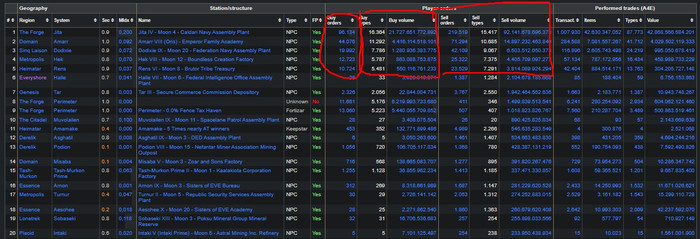 But is the total volume of goods so important if they are not sold? You have 100kk in assets, but the turnover is 100kk per month. Another example, you have 1kkk ISK in goods and the turnover there is 100kk per day. Of course, the second option is better. So, two parameters are actually important for the market, the ISK turnover and the number of trading operations: 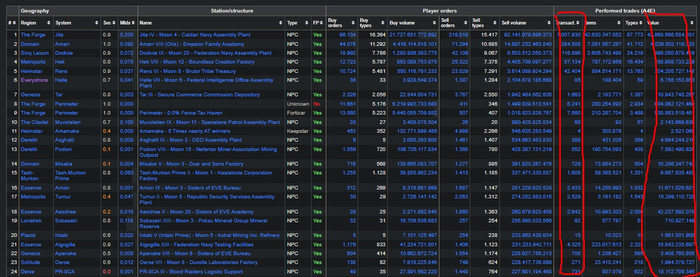 Specifically, the screenshot shows the turnover and trading operations for the last 7 days. You can filter the table by turnover or transactions to understand which are the most active markets in the game at the moment. Turnover rate and competition
Main article In short, when you have 100 blueprints or a set of goods that you build, production is established, and it even brings you some income, the question arises where to go next? How can you increase earnings or optimize the process? I bring to your attention the possible stages of construction evolution: Production stages Stage 1. Farm - 10, 100, 1000 blueprints available, but only 10 of them are enough to build. The reaction to order completion to build it again is very slow. Stage 2. Hauler - 10, 100, 1000 blueprints available, they are fully built, everything is sold on the market. Materials for construction are purchased in the trade hub and brought by truck. Hauler online, the reaction to order completion is slow. Stage 3. Automation - you have a buffer with materials for construction 10, 100, 1000 blueprints in the warehouse. The reaction to order completion is fast. Stage 4. Automation. Mark 2 - you have a buffer of finished items in the warehouse. The reaction to the completion of the order is very fast. Stage 5. Conveyor - the depth of orders that are sold allows you to assemble 100 fits of different types of ships at the station. Thus, you have time to react and build completed orders, and you also open the opportunity for fleets to gather at your market. Stage 6. Mega-factory - orders are boosted so that a full fleet of 250 pilots can gather at the station where you build. Stage 7. Industrial agglomeration - orders are boosted so that a full fleet of 250 pilots can gather at the structure where you build and another 250 fits are in reserve after the fleet is assembled in sell orders. The stage is unrealistic, if anything. And now, for each specific stage, but in more detail, and if you already understood everything, then you can stop reading o7 Stage 1. Farm In any way, mining, expeditions, scanning, agentrun, trading, etc. you earn ISK, for which you buy yourself blueprints improved in contracts, or improve them yourself, build items according to the blueprints and sell them. Everything is very simple, repeat this procedure until there are 100 blueprints or 10 billion in circulation. The wrong solution is not to stop and buy more and more blueprints, up to 1500 different items (according to OZ Eve at Fanfest, there are 40k different items in Eve, but only 1500 of them are in use). Because then you will always be at the farming stage, and you will endlessly mine ISK for construction. Imagine that in Factorio you have a bunch of bases, on all five planets, but the construction is not automated, and you just have to manually fill all the structures, it's the same here. Therefore, it is important to limit yourself to building a certain type or quantity of goods. For example, all T1 ammunition is 120 orders, or T1 rigs in use, about 80 orders. Or by building fits, such as: heron, scan launcher, plugs, scan rigs, data, relic, cargo scanner, engines, warp stabilizer, nano, inner stabilizers, damage controls, etc. And to the main core, add other scanners, such as probe, imicus, magnate, ventura, gas suckers for ventura miners, mining laser optimizers. Or you can limit yourself to ISK, for example, the volume is 10 billion. Which will allow you to move on to the next stage of construction. Because, remaining in construction as an eternal farmer, eternally young and eternally drunk, sooner or later you can burn out. Stage 2. Hauler Next, having decided on a set of goods, all of them are sold on the market by orders, the stage begins, where to get minerals for construction. Usually here people either farm ore themselves and understand that this is crap, or take a truck with the received ISK and buy minerals in Jita, take them back to the plant. At the trucker stage, you can become so full of your knowledge that you can training yourself 10 jump freighters and drive them non-stop from Jita and back. Earn a lot of ISK and eventually burn out, quit the game. How the guy did it in the interview with Oz Eve: EVE Online's largest industrialist - Interview with Sir SmashAlot https://www.youtube.com/watch?v=hGSHva5X6vc Stage 3. Automation You already have a set of blueprints, you learned how to buy materials for production in Jita and even bring them to the factory. What to do next? Let's simulate a situation, take a random region Verge Vendor:
And the purchase occurs depending on what you are building. If T1 items are minerals, T1 rigs are T1 salvage, T2 modules and ships are datacores, components, planetary, morphite, T1 items, T2 rigs are T2 salvage, components are reactions, etc. With a fixed set of blueprints, you can calculate how many materials you need to build them. For example:
But if you buy new blueprints for 10 billion instead of materials, then you will again find yourself at the farming stage with all the consequences with a lower turnover and profit, respectively. I do not recommend doing this. Regarding t2 construction, it is more difficult than t1 and rig because of:
In t2, 10 billion can easily turn into a full cycle of 30-40 billion, for automation and buffer in the warehouse. Lyrical digression I recently heard in a video, a person from powerblock claimed that if you can't build 1000 Hurricanes, then you are not a builder. But is it really so? How to get 1kk sp on main / Как получить на основу 1кк сп? On any account, even an old one, follow the link, and at the bottom under the fields, click "Log in to become a recruit". You don't need to fill out the form: 1млн навыков бесплатно сп / 1mln free skills. To build 1000 Hurricanes is:
It seems to me that this is primitive, and it is much cooler if you have automated construction like in Factorio, all the blueprints are planned in advance, you need to go to Jita once a month or not at all, a buffer of resources, compachs, reactions, etc. Now that's what you can really say, builder. Also, with a buffer of materials for construction, you insure yourself against invasions of drifters, pirates, Triglavs, gunkers, etc. Since there is no Jita or Amarr in your construction chain, or a very small percentage - for sanity, once a month. Stage 4. Automation. Mark 2 Congratulations, you don't go to the hub to buy stuff anymore or you do it very rarely. How can I boost the ISK turnover even more when I already have a buffer of resources for building in the storage? It's very simple (if I may say so) - you make a buffer from ready items! That is, 10 billion already turns into 20 with the purchase of resources and into 30 with the creation of a buffer in the storage. Why the hell do this? For example, you build all T1 cartridges and rockets, with a cycle of 7 days, someone flies in and buys the entire order from you! Now other buyers have to wait 7 days until you build the cartridges and put them up for sale again. Not very convenient, right? No one will wait 7 days. And what will happen when you additionally build not only in the order, but also in the storage: 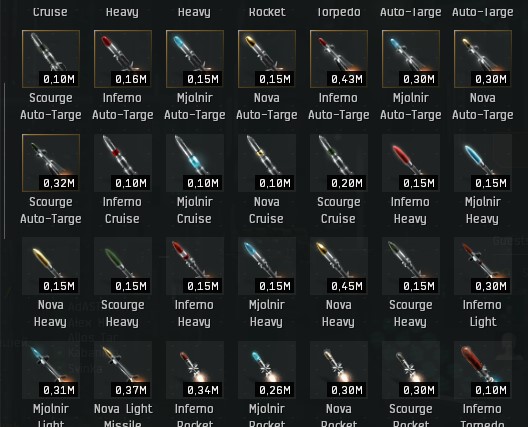 i.e. the order is over, you immediately put new missiles on sale and the blueprint that you took on construction. It is built in a week, while people calmly buy ammo for themselves, not upset that they are not available. Any supermarket in real life works on this principle. Put all the goods on the floor, fill everything that was disassembled again, shelves, and then do your own in the warehouse or chill. In T2 construction it is the same, with the T2 blueprint buffer you update the order from several hours to several days, and without it at least 7 days to update the goods for the sold out order. But that's not the limit, if anything, you can pre-build components in the warehouse there, or even reactions themselves for building compachs, if you need the "legendary masochist" achievement on steam. Stage 5. Conveyor Here you will begin to understand such a hat that it is easier to buy 100kk tritanium than 1kk. And it is easier to sell 10 nagas than one. The depth of your assortment. That is, if you built there more or less periodically, you could notice that before big battles there is always a mass purchase of ships, modules, rigs, and ammo. At the same time, the price does not always play a primary role, but the number of items in the position for sale is important. Also, a person will not bring you 1kk tritanium to earn 500k ISK. He will rather bring 100kk on a buy order and earn 50kk. Therefore, at the conveyor stage, there is a deepening of orders, the ability to buy and sell in bulk, at the station where you build. By the way, I forgot to say that with automation, you will notice an interesting joke - at the station where you are engaged in construction, buy resources and sell items, haulers and traders will start up. Because it is more convenient for the player when he can come, bring something to sell on a buy order, and buy from you on a sell, take it to sell at a higher price, so as not to drive empty. Traders and haulers will greatly revive the market and boost turnover. Stage 6. Mega-factory This is the builders' response to EVE streamers' complaints that there are no ships in Jita to assemble a fleet of up to 250 people. Hubs have often been empty lately, or ships are sold for three times the price. You can create competition with your factory and everyone will benefit from it. Stage 7. Industrial agglomeration The theoretical stage needs to be tested in practice. The idea is that you pay 500 PLEX monthly for factory rent to build something on it for 30 days. It's like a license, you can boost accounts with omega and build even faster, that's why many people do it. And here the idea is to go the other way around, to be able to set up so many assets in a month, so that later you can turn off factories for several months, waiting for the items to sell. Then turn them on again, and thereby save on omega. Is this realistic in practice, unfortunately I can neither confirm nor deny, check it yourself. o7 Second lyrical digression Let's talk about such a sore subject as Eve, war and competition. This mostly concerns Ukrainian players, that we can't compete with others in the game to the fullest extent, due to the fact that missiles and drones fly at night, and the lights go out periodically, due to shelling, sometimes it's on, sometimes it's off. I suggest treating this like running with weights on your arms and legs during a marathon. That is, everyone runs without weights, and we run with them, and it is not so easy. What is the advantage of such running, leaving aside the fact that it is not fair? I guarantee you 100% that you will outrun everyone when the weights are removed from your arms and legs. You will simply fly, overtaking everyone in front. This is the first thing. And secondly, the boomerang law works, everything you do sooner or later comes back to you and ultimately either the weights will be removed, or all the participants of this wonderful race will run in them o7 Now, regarding competition, comparing yourself with others, it is impossible to find peace. Since someone will always be better than you, so I suggest that in the game you compete first of all with yourself, this is the most healthy competition, to overcome yourself. By doing this, getting ahead of the rest will be an indirect result. 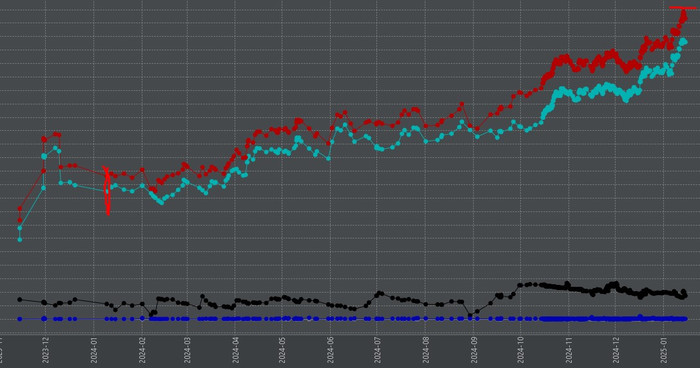 That is, for example, 10 conditional billions of ISK, compared to 120 trillion in Jita, is little, but if you had 5 billion a year ago, and now it's 10, then you are growing and have doubled your assets in construction in a year. In general, there is an English-speaking guy on YouTube who completed the game without ever buying Omega, he just made videos, they got views, he became a partner and they pay him Omega + 500 PLEX monthly. Further production development 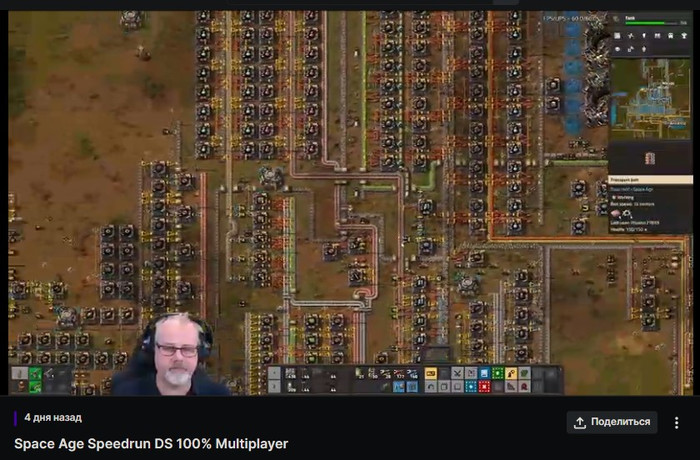 Space Age Speedrun DS 100% Multiplayer - nefrums on Twitch https://www.twitch.tv/videos/2351225288 An awesome topic, if you speedrun Factorio with ten people. The same can be done with construction in EVE at the expense of corporation projects. But how exactly, see for yourself o7 Production 5: Modernization 2025-08-11 14:01 alienshooter When manufacturing in Eve, sooner or later you will have to face the so-called "glass ceilings". Obviously, you may have noticed that for 30 inventory lines from one account, you don't need 30 production lines, but 60 or 90. And this, accordingly, means paying for another account, training it out, and an additional 500 PLEX for renting another factory every month. Then, for example, a rebalance patch comes out, and some type of resource: minerals, salvage, etc. becomes easier to collect, it becomes 25% cheaper, as was the case with morphite recently, and now to earn as much as before, you only need to build 25% more! Again, everything is solved by renting an additional factory and paying for another account, for a larger number of lines. Or you can go the way of improvement and modernization due to skills for anufacturing speed, implants, and of course citadels, which will be discussed in this article. I wanted, purely for myself, to calculate when it is profitable to install a structure, and in how long will it pay off in cost? We will gradually throw parameters into a heap and maybe in the end it will be possible to derive a formula for calculating the profit of installing citadels! 1) Types of structures The first Raitaru of our corporation was installed in one jump from Dodixie, following the example of Perimeter in Jita, with the aim of building cheaper goods than those that were sold at that time, 2020, I think. And for all the claims, in the end, it stood abandoned for six months, no one touched it. Then a patch came out where it was necessary to install expensive cores in the structures, and Raitaru died in the first wave of demolition of cytos due to cores from local Gallente pirates, who then moved to Amarr. Astrahus - 3 billion 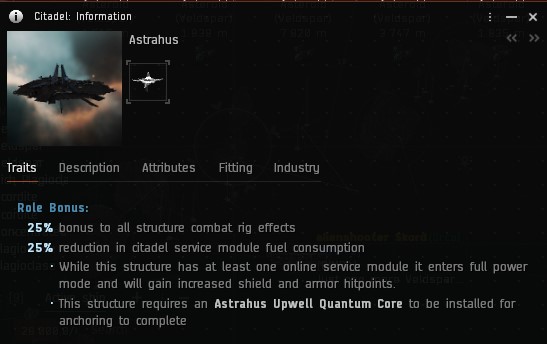 About 2-3 billion in fit, a discount on the cloning module for fuel and a bonus for combat rigs. Of all the medium structures, the most tanked and capable of equipped light fighters. Astrahus are installed so that there is an opportunity to dock often, these are wh, low, null, etc. where there are no NPC stations and cloning in the systems. Raitaru - 2kkk 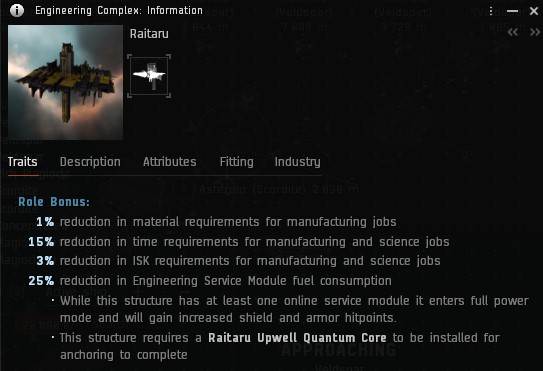 Own plant, compared to Astra is thin, but has good bonuses for production, namely:
In addition, with engineering rigs and space (low, high, null), you can significantly reduce your construction costs for materials. But, as you understand, such a hat as logistics appears. Athanor - 2 billion 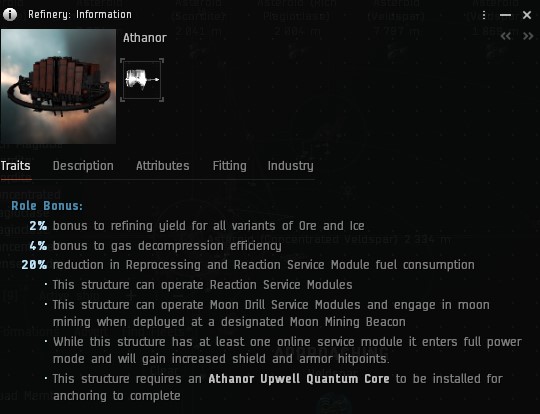 Everything related to the extraction of resources and their subsequent processing. Of the features:
Large structures are a feature of all large structures, the ability to stick a market, and 5 slots for modules. Additional reinforcement timer, armor. Fortizar - 20 billion 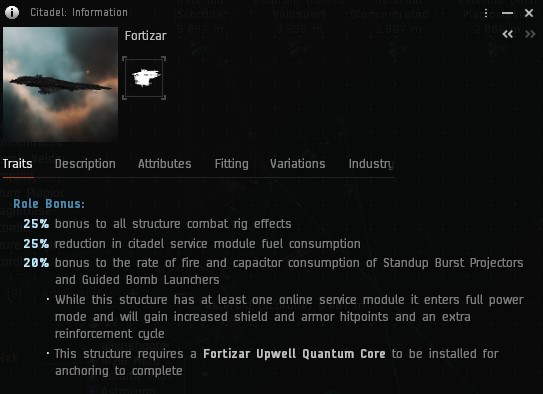 Astrahus's big brother, even more HP, fighters and attack modules. Like its predecessor, Fortizar is often used for strategic reasons. For example, in logistics, if I'm not mistaken, dreadnoughts can get to the fortizar. In wormhote in C2, for example, it is more difficult to evict from the fortizar than from the astrahus. An interesting topic of the fort is that the market module becomes available, this is 0% trading in plexes, injectors, extractors and free buy orders for any type of goods. And also large structures have "dual" rigs, with large bonuses compared to medium citas. Azbel - 10 billion 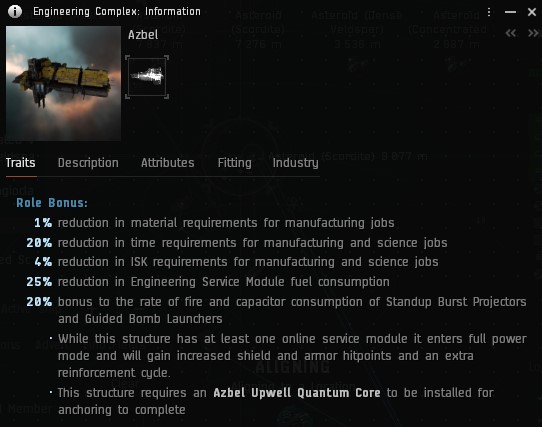 The elder brother of the raitary, from the new:
Tatara - 15 billion 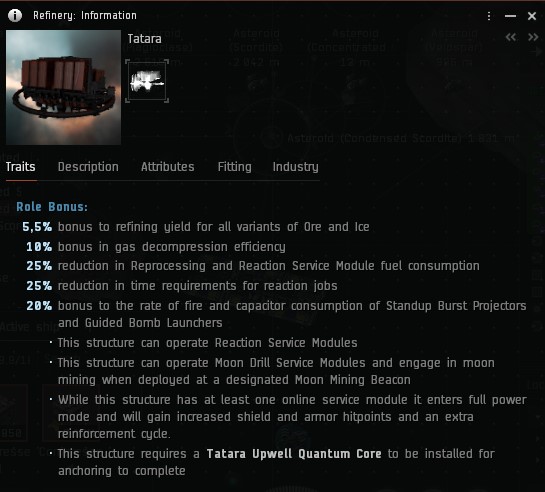 Improved version of Athanor, more tanking and better bonuses. It seems like in highs with a T2 rig you can get a max 75% yield from processing ore and ice, or even more?! For nothing to do, just for fun we'll add extra large structures. Of the features, you can't put them in highs. Titans and Supercars can be docked in Keepstar, and they can be produced on Sotiyo. Even better rigs with bonuses for construction and defense. More slots for modules. Sotiyo - 40 billion 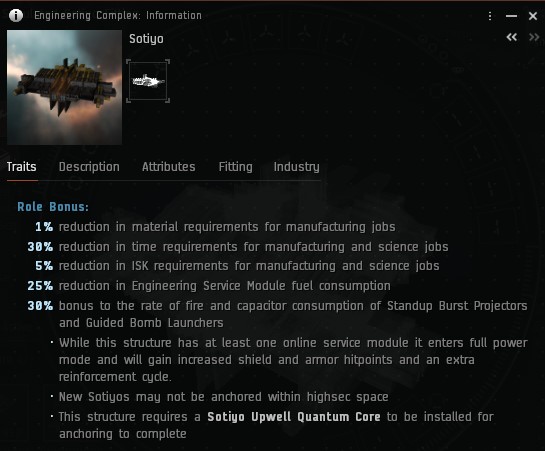 Max bonus for construction. Keepstar - 250 billion 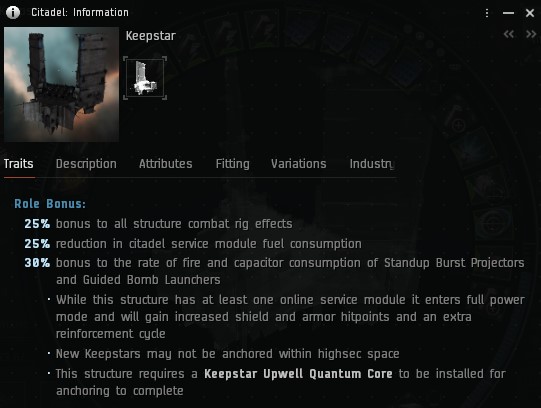 So, there is a certain set of structures with their cost. Let's move on to the next parameter on the list. How to get 1kk sp on main / Как получить на основу 1кк сп? On any account, even an old one, follow the link, and at the bottom under the fields, click "Log in to become a recruit". You don't need to fill out the form: 1млн навыков бесплатно сп / 1mln free skills. 2) Life cycle The second corp citadel was Astrahus in the highsector. It stood for one year, it came to installing a rig on it for building ships. In terms of costs, about 5 billion were spent on maintenance and about 50kk ISK in profit from taxes for using services. It was killed by highsector pirates, benders, a fleet of leshaks. In different parts of space, citadels live differently. Some for a long time, and some do not. You may be surprised, but the presence of a rig on a structure also shortens its life cycle. After all, the natural process of the free market sooner or later leads to a monopoly, the displacement of competitors, or even to unfair types of competition, in the form of sawing off a neighbor's structures. Let's take the pessimistic option that there is no fleet for protection and the tanking is on a timer for 3 am. Accordingly, now we will pass the citadels through various cosmos of New Eden, and see how long they will live: 1) Capitals of lowsec collectives. Unlucky, opened wormhole:
6) Wormhole C1:
Now, in addition to the cost of the structure, we also have a visual representation of its lifespan. For further comparison of results, you will need preparatory material: Activity "The third structure of the corp was Astrahus in Wormhole C1. It stood for one year, was cut out by a multiboxer on Eos and Nestors, 20-30 windows, no chance." All types of activities in Eve are divided into three types, like the structures listed above, you either:
All other activities, this can be said to be an addition to the three main ones above. The interesting thing is that the extractor can live on astrahus. For example, the same wormhole, he just farms and spends the night in the citka. And the merchant can use azbel, because there is a trading module enabled there, etc. The ratio "Athanor was the fourth corporate station, on it they mining the moon every week at 0.5 for several months until it was demolished by local lowsec pirates." Let's compare the prices of structures to their life cycle: 1) Capitals of lowsec collectives. Unsuccessful, opened wormhole:
Conclusion Having compared prices and relative lifetimes, we have received a minimum turnover per day from construction and trade, or profit from PVE extract classes, if the structure was installed for the convenience of farming. If the citadel was installed to get fun and fights, then it will be possible to clearly see how much of the opponent's ships need to be killed per day and how much time it takes for the costs of such fun to be justified. Thus, you can tank not only with a defense fleet or a 3-am timer, but also with turnover from the installed structure. Pay off the citadel faster than the pirates will destroy it. Install a new one and live on the difference. Fuel "The fifth citadel was again an astrahus in C1, stood for 30 days and was demolished by a solo guy in three windows, two marauders and a hauler with cap batteries. Which was then demolished by random guys, in his C1 dreadnought phoenix and fortizar, 2 months after the astrahus was washed away." It is important to mention that the calculations were made without a monthly fee for modules operating on the citadel. They can be added to the cost. Like taking the cost of the citadel per day and adding fuel costs. You get a clear minimum turnover, an indicator of when you can put the structure. Pandemic-Goons war 2025 With the sudden attack of the Goons on the Pandemics in June, the turnover in trade and production increased greatly. In 10 days, the turnover reached the monthly norm, and then returned to the normal summer minimum. It would have been possible to make x2 profit if there was a greater depth of orders, manufacturing lines, production capacities, or a buffer in the storage of finished items / raw materials. Interesting conclusion, those who produce / supply weapons for it love war the most, they will support it in every possible way so that it does not end. And the question of workers from a military factory in real life "When will we be able to earn so much money?" sad, but current reality. An unbreakable wall? 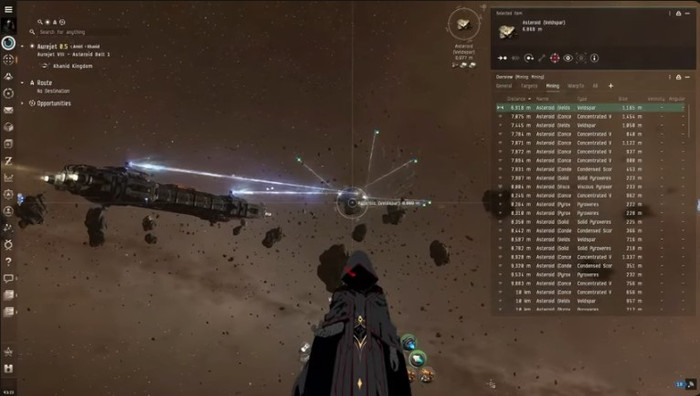 https://www.youtube.com/watch?v=Y-nxmxpoL7g Written based on a video where the author shares his experience of building in the game. In short, he farmed ISK for a month to buy a sotiyo, put it in lowsec and build motherships and Titans on it. The idea is basically good for a newbie in the game. He paid some guys to guard him during the installation of the citadel, but they never showed up, taking the money. And when he was taking the core and blueprints to sotiyo in a truck, he was killed by low-sec pirates, who demanded several billion so that they wouldn't blow up sotiyo. But he didn't have any isks at all because he spent everything he had. And they blew up his structure, and the guy left the game for a year. This is a standard trap, which teams that play for 10-20 years, catch newbies and new corporations, not allowing them to develop. That you invest all your ISK in one thing, they drain it from you, you leave the game. Be it a vexor for expeditions in low, an multispectrum with 4/10 inside a gila in Uedama blown up by gankers, or a phoenix navi dreadnought on the 5th agent, dropped by a dozen dreadnoughts. The author of the video came to the conclusion that 10-20 year old corporations are sitting on resources and do not allow new teams to develop. Since they are deeply entrenched in space, they have concreted everything. This is a kind of impenetrable wall, and here the choice is you either join these teams as a pilot or a corporation (you become "part of history" or "a legend" :), they absorb you, or they simply do not allow you to develop. Moreover, in any space. It's good that everything has a beginning and an end o7 And as in evolution, it is usually not the strongest species that survives during changes, but the one with a mutation capable of resisting new conditions. The remaining species are simply discarded by nature and die. And the mutated species continues to develop in the new world. \0/ |
| В избранное | ||

